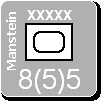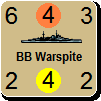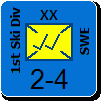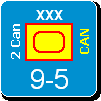warspite1
Posts: 41353
Joined: 2/2/2008
From: England
Status: offline

|
Please see attached the next USN example (this time a battleship write-up). This is the USS Arizona and contaiins details of the attack on Pearl Harbor.
[4071 Arizona - by Robert Jenkins]
.B Engine(s) output: 33,375 hp
.B Top Speed: 21 knots
.B Main armament: 12 x 14-inch (356mm), 20 x 5-inch (137mm) guns
.B Displacement (full load): 35,929 tons
.B Thickest armour: 14-inch (belt)
.P The Pennsylvania`s were a two-ship class of battleship dating from the
First World War. In company with other US battleship classes from that era, they
were essentially reconstructed during the inter-war years to rectify their main
deficiencies; lack of underwater protection and a lack of main armament
elevation.
.P Their modernisation took place at the start of the thirties and the technical
data above reflects their status post this work. Their main armament remained
the same, but was improved so that the guns could elevate to thirty degrees. Six
of the original twenty-two five-inch secondary guns had been removed after World
War One and now a further four guns were removed, with the remaining weapons
being refitted higher up to avoid operational problems in high seas. An
additional eight five-inch anti-aircraft (AA) guns were also fitted.
.P Their machinery was given a thorough overhaul and new boilers added, although
they remained slow when compared to modern battleships. Armour was added to
provide better protection against torpedoes and shell fire.
.P Visual changes included the replacement of the existing masts with a tripod
arrangement.
.P Arizona was commissioned in October 1916 and at the outbreak of war with
Japan in December 1941, she was based at Pearl Harbor; sadly her war was to last
just one day.
.P President Roosevelt gave the order to move the Pacific Fleet from the US west
coast to Pearl Harbor in the Hawaiian Islands in spring 1940. The order had been
given in response to growing anxieties about Japanese intentions, and was
calculated to send a signal to Tokyo that the US were not prepared to sit back
while the Japanese did as they pleased in China.
.P The Commander in Chief of the Japanese Combined Fleet was Admiral Isoroku
Yamamoto. He was tasked with coming up with a plan for war with the United
States. He knew that American industrial might would make it difficult for a
country like Japan, with its lack of natural resources, to win a long war. If war
had to come, then the only option was to strike first and strike hard and in
doing so, hope that the Americans would want to quickly sue for peace. The plan
that he designed, called for an attack on the Pacific Fleet within minutes of a
declaration of war. The attack would come from aircraft of the elite 1st Air
Fleet and, if surprise could be achieved, would lead to the destruction of the
American battleships and carriers.
.P Pearl Harbor was designed as the first of three distinct phases. Having
destroyed the American Fleet, the Japanese would then create a perimeter around
Japan, by invading to the west as far as India, to the east as far as Midway,
and to the south as far as New Guinea and the Solomons. All territories and
islands within that perimeter would be conquered under the plan, including the
Philippines, the Dutch East Indies, Malaya and a host of Pacific island chains.
The third phase would be to build up sufficiently strong defences all along the
perimeter, that the Allied forces would not be able to break back-in and would
have to sue for peace.
.P The attack was entrusted to Admiral Nagumo, a cautious individual who did not
have a background in carrier warfare. His forces were made up as follows: the
1st Air Fleet that contained the fleet carriers Akagi (Nagumo`s Flagship), Kaga,
Soryu, Hiryu, Zuikaku and Shokaku, two battleships Hiei and Kirishima, two heavy
cruisers Chikuma and Tone and accompanying destroyers. There was also a heavy
submarine force and two supply columns, although the Japanese submarines proved
entirely ineffectual. Nagumo`s force left Japanese waters on the 26th November
1941 and headed east under strict radio silence.
.P Meanwhile, in Pearl Harbor, the Americans went about their business as usual.
In the middle of the harbour area was Ford Island, a rectangle of land about
2,000 metres by 1,000 metres. This island had plenty of space for ships to anchor
around including, in the north-east corner, battleship row, which, as the name
suggests, is where the battleships of the Pacific Fleet were normally anchored.
The attack was planned for a Sunday morning, when the US forces were expected to
be at their least prepared. Luckily for the US Navy, the carriers Lexington,
Enterprise and Saratoga would all be away from Pearl Harbor on the date of the
attack; 7th December. This was not true of the battleships however, and they
would be at anchor on that sunny December morning, lined up on battleship row.
Running roughly west to east and in pairs side by side were Maryland and
Oklahoma, then Tennessee and West Virginia, then Arizona alongside the repair
ship Vestal and finally Nevada on her own. California and Pennsylvania were
located away from Battleship row, the former about 500 metres to the south-east
and the later in drydock no.3. For reasons beyond the scope of this write-up,
the Japanese attacked Pearl Harbor before a declaration of war had been
delivered to the Americans.
.P The Japanese plan called for aircraft of the 1st Air Fleet to launch three
waves of attacks. There were a number of aircraft types employed, the most
important of which were the Aichi "Val" dive bomber, the Nakajima "Kate" torpedo
bomber and the Misubishi "Zero" fighter. At 0530hrs the first wave of one hundred
and eighty-three aircraft took off. They were picked up by US radar at just after
0700hrs, but were mistaken for US B.17`s that were due to arrive in HaWaii later
that day.
.P Just before 0800hrs the Japanese aircraft went into the attack. In addition
to the ships at Pearl, the airfields at Kaneohe and Wheeler Field were attacked
as were the aircraft on Ford Island. Amongst the first ships hit were the
Pennsylvania, the target ship Utah and the cruiser Raleigh. They were followed
by the cruiser Helena and the minelayer Oglala. By now the warships were a mass
of men moving as quickly as they could to action stations to begin firing back
at the enemy. A torpedo bound for Vestal then went underneath the repair ship
and struck the Arizona lying alongside. Just a couple of minutes later, a bomb
penetrated one of the battleship`s magazines. With this, Arizona exploded and
then began to sink. Then, three torpedoes found Oklahoma in quick succession,
causing her to roll-over and a fourth caused her to capsize. With everything
happening quickly, Arizona was found by another bomb and a second magazine
exploded. Perhaps one of the luckiest breaks the Americans received was that the
tanker Neosho, full of aviation fuel and moored on battleship row at the start of
the attack, was not hit (see Transport Counter 4243).
.P Meanwhile, Nevada had been hit by a torpedo and was beginning to list when
her captain ordered her to get underway. Fuel oil from the stricken Arizona had
ignited and was heading toward her. Later that morning, While slowly heading for
the harbour`s only outlet to the sea, Nevada was pounded with bombs and was in
danger of sinking. Quickly realising that if Nevada sank in the channel, the
harbour would be blocked and out of action, her captain purposely beached her.
While all this was going on, California and West Virginia had both taken further
punishment, the WeeVee, receiving two bombs and six torpedoes. Tennessee and
Maryland were also hit.
.P Much of the devastation described above had been caused in just a few minutes
by aircraft of the first wave and the second wave followed close on its heels.
Like the first, this second attack struck against the airfields around Pearl
Harbor as well as inflicting more misery on the once proud battlefleet. As she
was in drydock, Pennsylavania had been partially protected from the bombs and
torpedoes and as a result took only one bomb hit. However a near miss struck the
destroyer Shaw, taking the smaller ship`s bow off.
.P Nagumo was urged by his returning pilots of the first wave to launch the
planned third wave. However, the cautious Vice-Admiral, perhaps influenced by the
exaggerated claims of the pilots who indicated their work was done, decided that
it would be too great a risk to return to Pearl Harbor again, especially given
that they did not know where the American carriers were.
.P The Japanese withdrew, leaving behind many burning and sinking ships of the
US battlefleet. Arizona would never be re-floated, Oklahoma was not to return to
action and all other battleships had taken at least one bomb or torpedo and
would require substantial repairs. There was widespread damage to cruisers,
destroyers and other shipping.
.P The Americans had lost around 2,400 military and civilian lives during the
attack. Most of these came from the Arizona and over three hundred aircraft were
destroyed or damaged. All of this was achieved at a cost of less than one
hundred and ninety Japanese pilots, but the attack had not been entirely
successful. The Japanese had not caught the three precious carriers of the
Pacific Fleet in the harbour, and they had been less than thorough in their
destruction of some of the harbour installations, including the oil storage
tanks.
.P What the Japanese had achieved, in a way that the American political
establishment never could, was to unite the United States and to give them a
clear purpose; to avenge Pearl Harbor. Yamamoto knew only too well of the
industrial potential of the United States and whilst he may never have said
the words accredited to him at the end of the film Tora! Tora! Tora! it appears
from contemporary evidence that they certainly conveyed his feelings: "I fear
all we have done is to awaken a sleeping giant and fill him with a terrible
resolve."
_____________________________
England expects that every man will do his duty. Horatio Nelson October 1805  |
 Printable Version
Printable Version












 Please see below:
Please see below: 



 New Messages
New Messages No New Messages
No New Messages Hot Topic w/ New Messages
Hot Topic w/ New Messages Hot Topic w/o New Messages
Hot Topic w/o New Messages Locked w/ New Messages
Locked w/ New Messages Locked w/o New Messages
Locked w/o New Messages Post New Thread
Post New Thread